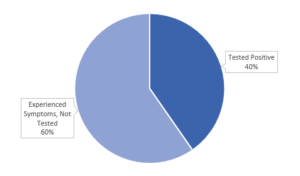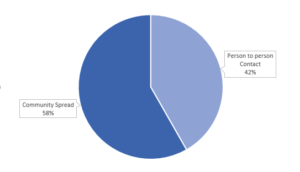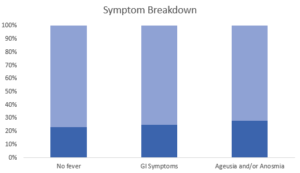
With the onset of the COVID-19 pandemic, Sanguine partnered with researchers to develop treatments for the virus. As innovators in medical research, we realized we had the power to make a difference through our at-home research model. Since March, Sanguine has partnered with multiple researchers to facilitate over 18 research studies all aimed at understanding the novel coronavirus, and developing new treatment and vaccine options.
With the launch of our COVID-19 research studies, we have received over 650 sign-ups from individuals who have recovered and are dedicated to making a difference for others. Of those, over 450 individuals have been screened and many of them have already participated in safe, at-home appointments. Through our over-the-phone screenings, we have come across some interesting findings.
Of the 481 recovered individuals that were screened, only about 194 of them had either verbal or written documentation of their COVID-19 diagnosis. That means only about 40% of those that experienced symptoms were actually tested and received a positive diagnosis of the virus.

In a more detailed screening with individuals that tested positive, we asked participants whether they were in contact with someone known or suspected to have COVID-19. Only about 81 out of 194 individuals answered yes. This indicates that 60% of participants most likely contracted the virus through community spread.

According to the Center of Disease Control (CDC), common COVID-19 symptoms include cough, shortness of breath, fever, chills, headache, sore throat, muscle pain, and loss of taste or smell. While many of the individuals we have screened experienced a combination of these symptoms, we have also come across others such as fatigue, body aches, chills, nausea, diarrhea, chest pain, loss of appetite, congestion, and dizziness.
While respiratory symptoms seem to be common in those with COVID-19, some individuals have experienced other types of symptoms as well. We found that 30% of those surveyed experienced some sort of Gastrointestinal (GI) symptoms such as diarrhea and nausea. GI symptoms have not been included on the CDC list of main symptoms, but seem to be more prevalent than previously noted. Also, over one-third of diagnosed individuals experienced ageusia or anosmia (loss of smell or taste respectively). Ageusia and Anosmia were only recently added to the CDC list of symptoms. While many COVID-19 patients did experience fever as a differentiating symptom (from the common cold and seasonal allergies), we now know that the presence of a fever is not necessary in order for an individual to test positive or experience COVID-19 symptoms. Approximately 30% of diagnosed individuals did not experience a fever.

Key Findings
- Only 40% individuals who signed-up were actually able to get tested and received either written or verbal confirmation of their COVID-19 diagnosis
- 60% of individuals likely contracted the virus through community spread
- 30% of diagnosed individuals did NOT experience fever as a symptom
- Approximately 30% of diagnosed individuals experienced some sort of GI symptoms
- About 38% of diagnosed individuals experienced loss of taste and/or smell
Main Takeaways
It is perhaps not surprising to find that many individuals (60% of our sign-ups) could not get tested because of limited and/or prioritized testing. However, this does bring into question whether all those that experienced symptoms had actually contracted the virus. COVID-19 can have symptoms that are similar to the common cold, flu, and seasonal allergies; therefore, it is difficult to determine whether one was infected without testing. It is perhaps possible that a significant number of individuals who experienced symptoms, did not, in fact, have the virus. According to the COVID-19 Tracking Project, over 8 million people in the U.S. have been tested for COVID-19. Of those, only about 1.2 million tested positive. This indicates that only about 14% of those tested actually contracted COVID-19. On the flip side, many asymptomatic individuals may never know if they had contracted the virus and so cannot be included in national data.
While our findings aren’t representative of the U.S. population, they provide insight into the broader range of symptoms individuals are experiencing and raise questions about testing and virus contraction. Scientists and researchers are hard at work to understand COVID-19 better, but there is still much that we do not know. With more research, we can not only have a better understanding of the patterns and effects of the virus, but can also facilitate the development of a vaccine or cure. If you or your loved one were diagnosed with COVID-19 and have recovered, please sign up to participate in one of our at-home research studies. Together, we can make a difference in the fight against COVID-19.
For more information about COVID-19, please visit the CDC website


